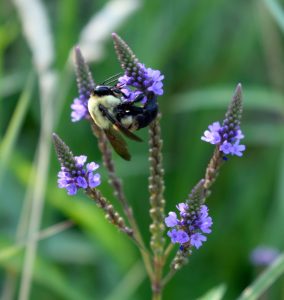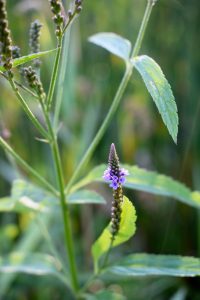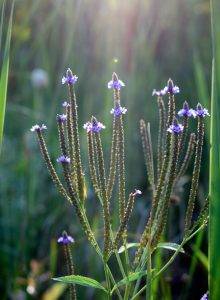Blue Vervain
 Verbena hastata is also known as swamp verbena, wild vervain, wild hyssop, and blue verbena. In Old Latin, ‘verbena’ translates as ‘sacred bough’ and ‘hastata’ as ‘equipped with a spear’, or ‘spear like’. Blue vervain’s flowerheads are indeed spear like, for the spike keeps growing outward as the flowers form and mature, with new flowers emerging at the tip and the fruit ripening below. Leaves are about 1″ wide, and can grow to 7″ long.
Verbena hastata is also known as swamp verbena, wild vervain, wild hyssop, and blue verbena. In Old Latin, ‘verbena’ translates as ‘sacred bough’ and ‘hastata’ as ‘equipped with a spear’, or ‘spear like’. Blue vervain’s flowerheads are indeed spear like, for the spike keeps growing outward as the flowers form and mature, with new flowers emerging at the tip and the fruit ripening below. Leaves are about 1″ wide, and can grow to 7″ long.
One day in early August — in the height of blue vervain’s June through September flowering period — I found a clump growing in their typically sunny, moist habitat along the edge of a marshy area abutting the walking trail. Other flowers in bloom alongside them included swamp milkweed, yarrow, wild mint and monkey flower. Slightly sloping away from the trailside was a wetter, marshy area full of cattails drinking in the sun. Wet meadows and moist roadside ditches are also likely places to find blue vervain.

The spiky flower panicles of blue vervain attract a splendid array of insects, bee species and butterflies to its nectar and pollen. One of the bee species flocking to this important pollinator plant is a vervain bee specialist, the verbena bee (Calliopsis nebraskensis). Calliopsis is a small genus in the mining bee family whose fast flyers visit vervain plants exclusively. Using special combs on their forelegs to extract pollen from the flowers, female verbena bees bring back vervain pollen to their solitary nests in the ground, using the foraged pollen to feed their young. This type of specialist pollinator is important for vervain, for it guarantees that just about every flower will be thoroughly visited ensuring successful pollination.
In Minnesota, cardinals, field sparrows, swamp sparrows, and juncos are frequent visitors that enjoy the ripened seeds. Although cottontail rabbits eat the foliage, most mammals avoid the bitter taste. The leaves, however, serve as host plant for the larvae of the common buckeye butterfly among others.
Plants were once one of the pillars upon which human civilization stood. Knowledge of their properties was shared over millennia across cultures deeply valuing flowers for their symbolism, medicinal healing benefits and spiritual connection to nature. Going back to ancient times, vervain’s European cousin, European vervain (Verbena officinalis), was treated as an herb of cleansing, blessing and healing. Ancient Greeks believed that every thing on earth held a direct link to the gods, with individual flowers being sacred to specific gods. European vervain, for example, was a holy herb used to clean Zeus’s temple altar prior to rituals and sacred occasions; priests in early Rome believed that vervain was formed from Juno’s tears, and called the plant, herba sacra. This explains how the genus name for this group of flowers came about, because in Latin ‘verbena’ (sacred bough) refers to plants highly esteemed for their use in sacred rituals.
thing on earth held a direct link to the gods, with individual flowers being sacred to specific gods. European vervain, for example, was a holy herb used to clean Zeus’s temple altar prior to rituals and sacred occasions; priests in early Rome believed that vervain was formed from Juno’s tears, and called the plant, herba sacra. This explains how the genus name for this group of flowers came about, because in Latin ‘verbena’ (sacred bough) refers to plants highly esteemed for their use in sacred rituals.
Our native Verbena hastata here in North America cones with its own history as a powerful healing herb. All parts of the plant can be used medicinally. Both the Dakota and Omaha-Ponca First Nations have names for Verbena hastata that translate as ‘medicine’ and ‘herb medicine’. The ethnobotany of this plant as a medicinal herb includes a variety of ailments it is purported to address, including depression, anxiety, headache, jaundice, and cough as well as used externally for healing skin conditions.
Occasionally, I brew a tea infusion for a nervine tonic that includes the dried flowers and leaves of blue vervain. NOTE: Use in moderation, as blue vervain in large amounts can interfere with blood pressure medication and hormone therapy, among other side effects.

For me, it is remarkable to discover an entire world wildflowers give us from the bygone perspective of historical value and traditions. In blue vervain’s case, this past lore has fallen literally to the side of the road (assuming it is a wet ditch!). That warm morning in August, my little sojourn brought me to blue vervain, which in turn led to learning this flower’s interesting story. My return visit, subsequently, turned into a pilgrimage of sorts — this time with the intention to sit, admire and pay a bit of homage to blue vervain. The sun shining down through myriads of morning dew drops resting on those purple crowned ‘spears’ created prisms of tiny rainbow light all around the marsh, sanctifying the gifts bestowed on us from our very own Mother Nature.
I’m grateful our wildflowers do endure through time in spite of us. They persevere through their own generations of renewal, taking in and reveling in the sunshine — even if we sometimes refer to them as ‘weeds’!
https://plants.ces.ncsu.edu/plants/verbena-hastata/
https://www.washcoll.edu/learn-by-doing/food/plants/verbenaceae/verbena-hastata.php
https://nj.gov/dep/parksandforests/natural/heritage/docs/verbena-simplex-narrow-leaf-vervain.pdf
the verbena specialist bee info. is just above.
more about the specialist bee: https://www.houzz.com/magazine/keep-an-eye-out-for-fast-moving-calliopsis-bees-stsetivw-vs~72146398
